
There are multiple methods for providing winter protection to roses. These guidelines provide an overview of the options and include enough information to successfully winter rose plants in cold climates.
Rose Hardiness

Roses vary quite a bit in their cold hardiness across different rose classes and even among different varieties in the same class. Gardeners in cold climates should take care to choose varieties appropriate for their hardiness zone, to minimize the need for too much extensive winter protection.
All but the hardiest shrub roses may require protection when grown in cold climates where winter temperatures fall below 0°F (zone 7 and below). With a good variety of choices, gardeners in zone 6 and above usually do not need to take significant efforts to protect roses in winter.
Gardeners in colder climates can help themselves by selecting roses grown on their own roots, rather than being grafted. “Own root” varieties are varieties that can regrow from their roots if they get severely damaged by extremely cold winter conditions. If bud grafted roses freeze hard, due to a lack of adequate winter protection, there is a potential that only the rootstock rose will re-grow in the spring.
Good Culture Promotes Hardiness
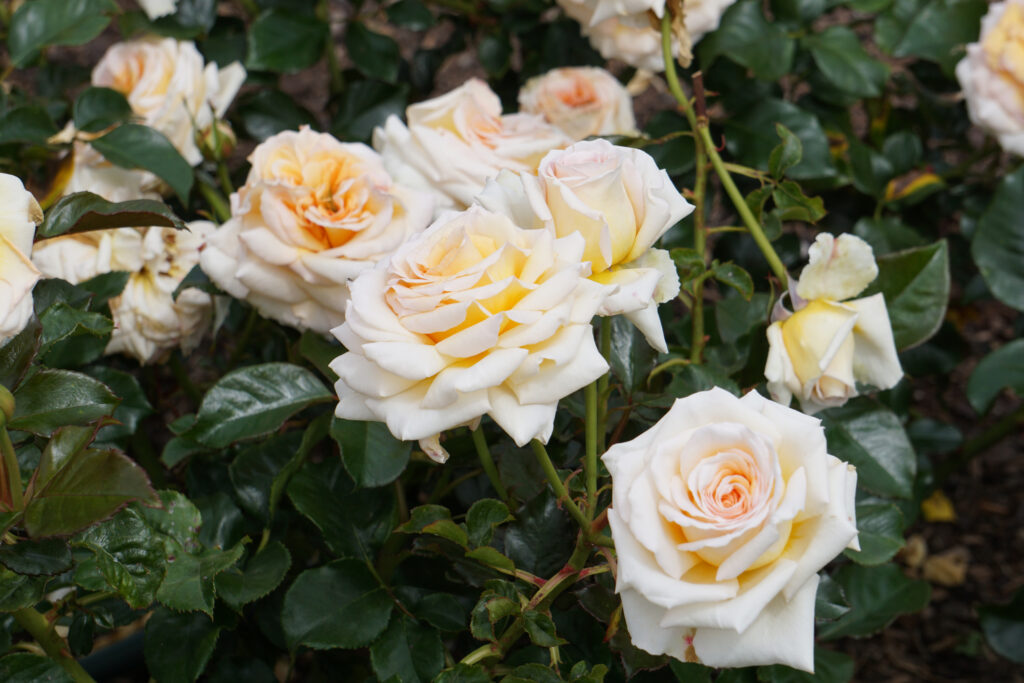
Winter protection begins much earlier in the season. Planting roses in an appropriate site with well-drained soil helps to ensure they can survive winter’s wrath. Planting roses in heavy, poorly drained soil makes the prospect of successful overwintering much more unlikely.
Vigorous, healthy roses will be more cold hardy than weak, stressed, or diseased plants. Good culture throughout the growing season is another critical foundation for their winter survival. Always protect plants from insect and disease damage, while maintaining proper watering and fertilizing during the growing season.

In northern zones, it is also critical to stop fertilizing roses by the end of July. Although it is important to keep a plant vigorous and healthy through the growing season, fertilizing too late in the season can promote excessive late growth that may not harden off fully before winter, subjecting plants to severe potential harm from a cold winter.
It is also important to allow September blooms to remain on plants. No more pruning or dead-heading after Labor Day! Removing spent blooms encourages new growth which may cause roses to suffer similar winter damage if they are not properly hardened off. By allowing September blooms to remain on the plants, plants are forced to begin preparing for their winter dormancy period.
Fall Clean-Up for Roses
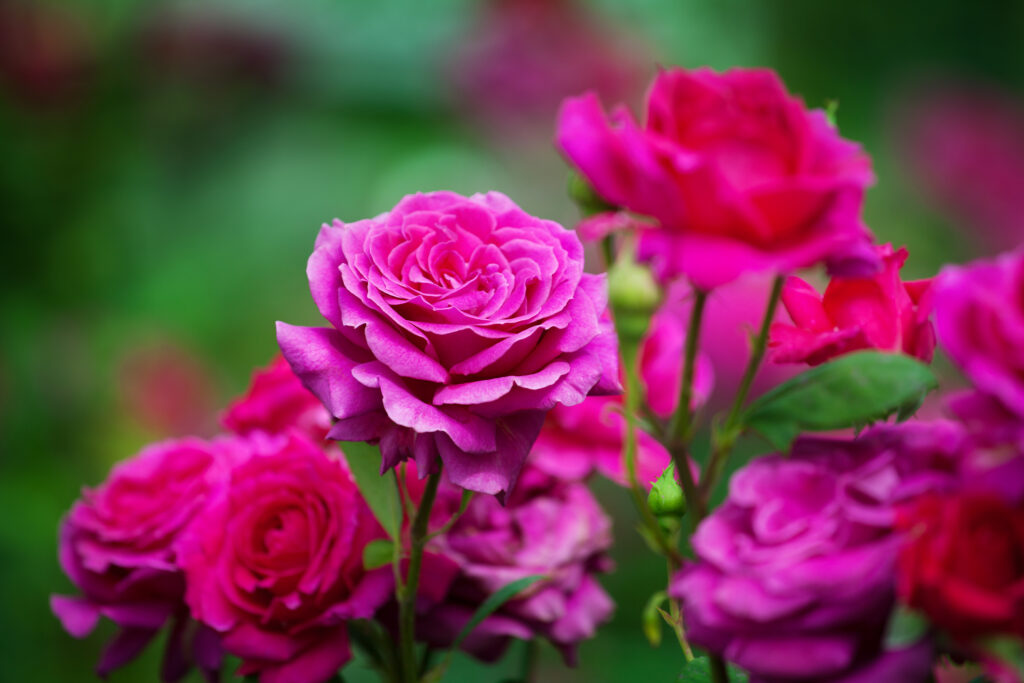
Thoroughly clean up leaves and flowers after a killing frost. Once temperatures have fallen into the lower twenties. By this time rose plants will have stopped growing. If a black spot has been a problem with your roses the past season, careful clean-up can help reduce disease symptoms during next year’s season.
Plants and the surrounding soil can also be sprayed with a horticultural oil spray to further reduce the survival of overwintering of pests and diseases. Always read and follow label directions carefully when using pesticide sprays.
It may seem counterintuitive but watering plants thoroughly just before the ground freezes, in late fall will help protect roses from desiccation or drying out during winter.
Winter Rose Protection Methods
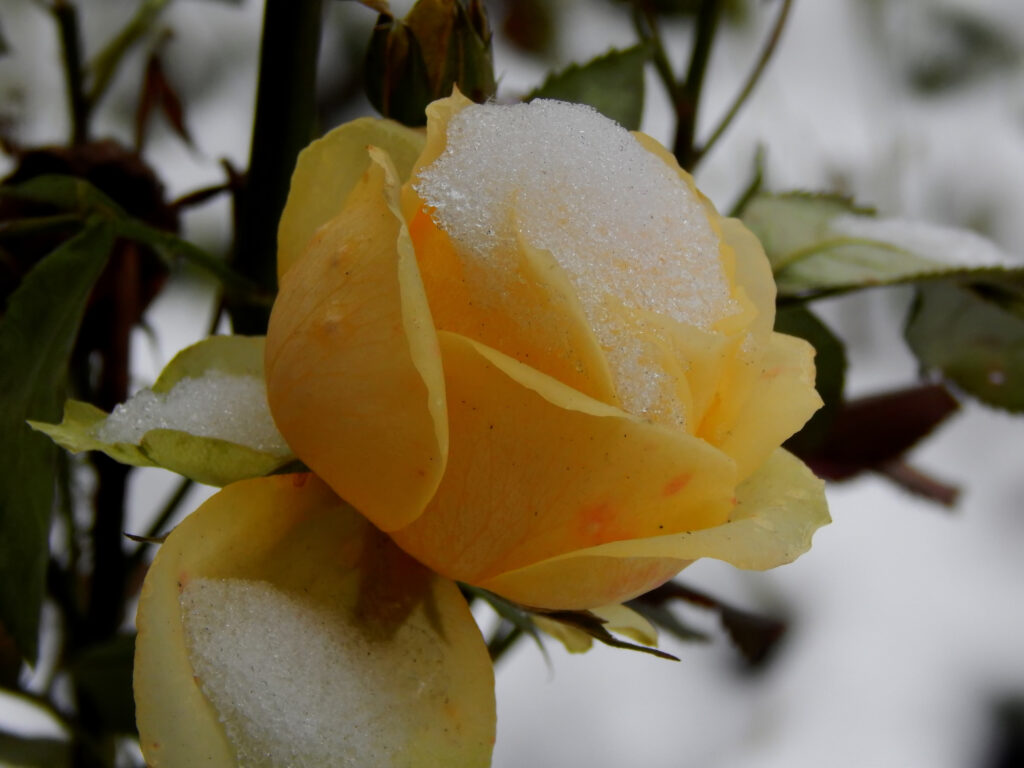
Tying Canes
Tie the canes together with a soft cloth before the ground freezes. This helps make plants more manageable to work with when taking further protective measures.
Hilling Up
The most traditional way to protect rose crowns is in winter is “hilling up.” This is done by mounding six to ten inches of soil or compost over the crowns of plants. The soil or compost should not be taken from around the bases of the plants but from another location. If roses were planted properly, with the graft 2 to 3 inches below the soil surface, 6 inches of soil over the graft should be sufficient. If the graft was not buried at planting or you know from past experience that a variety is particularly tender, increase the covering to 8 to 10 inches.

Mulching
After the ground has frozen lightly, cover the mounded plant with an organic mulch like straw, marsh hay, bark, pine boughs, or shredded leaves. Apply this mulch 6 to 12 inches deep over the canes. If your plants are in an open or windy site, use a wire cage, a collar of fiberglass or tar paper, or burlap covering to hold the mulch in place.
Rose Cones
Rose cones are another option for winter protection. When using rose cones, select a cone large enough to not require a significant cutting back of the canes. Trim canes just enough so the cone completely covers the plant.
Punch 4 to 6 pencil-sized holes in the top and bottom of each cone to ensure there is good ventilation. Heat can build up inside cones that are not ventilated and reduce overwintering success. Make sure cones will not blow away by anchoring them with soil, bricks, stones, or stakes.
In colder climates, or for more tender varieties, some gardeners cut the tops off of cones and fill them with organic mulch.
Winter Care Tips for Tree Roses
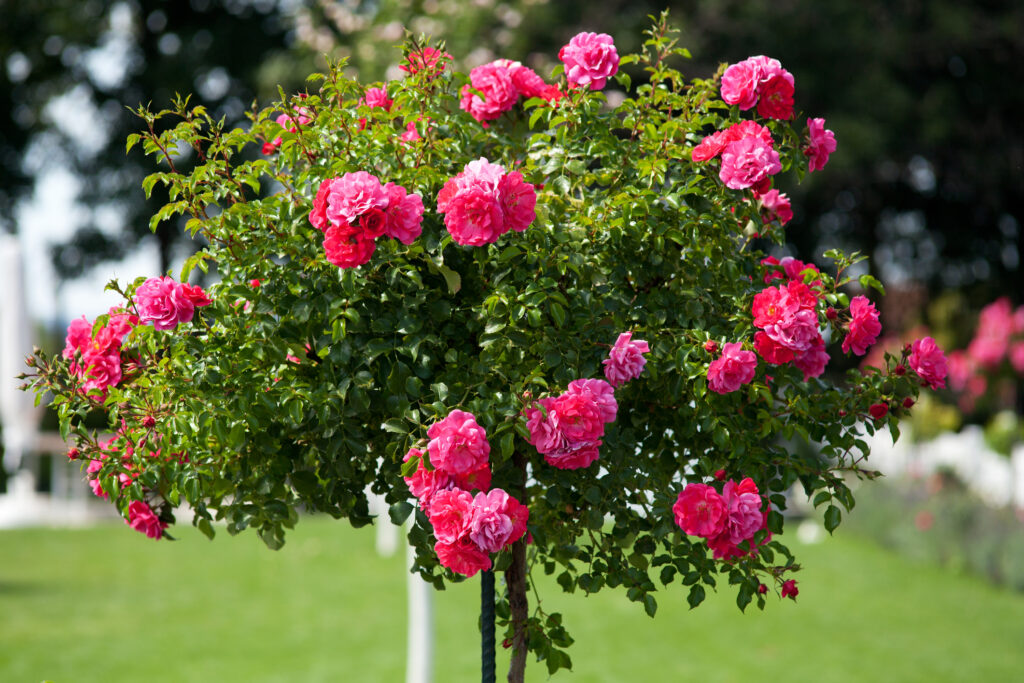
Tree roses, sometimes called “rose standards” are hybrid tea or floribunda roses grafted with a tall trunk. Tree roses are very tender and require special protection in winter because their graft unions are exposed.
There are three general ways to winter tree roses. The first method is for tree roses growing in containers. Containerized plants can be moved to a protected location before the soil freezes, usually around the first part of November. Ideally, the location maintains a temperature just above freezing from November through March. This is cool enough to keep plants dormant but warm enough to prevent winter damage. Unheated attached garages, glassed-in porches, and minimally heated greenhouses are examples of structures that have worked for many northern gardeners.
The second option is trenching (sometimes called the “Minnesota Tip”, as it is also used to protect regular roses in very cold climates.) In this method, an entire plant is buried in a horizontal trench large enough to accommodate the entire tree rose including the roots. Before the ground freezes, dig up the dormant tree rose or potted plant and lay it horizontally in the trench, covering all parts with a minimum of six inches of soil.

Instead of completely digging up plants, they can be “tipped” by loosening the soil opposite the trench with a garden fork. Carefully use the fork to tip the plant over into the trench, leaving some of the roots anchored in the soil.
After the soil freezes lightly, cover the trench with 12 to 18 inches of mulch. Remove the mulch in early spring and remove the soil as it thaws, then replant the tree rose.
The final method is to hill up soil at the base of the tree rose, then wrap and mulch the upper part of the plant with an organic mulch held in place with a burlap wrap, chicken wire, or a wood frame. There should be 12 to 18 inches of mulch around the entire plant.
Winter Care Tips for Climbing Roses
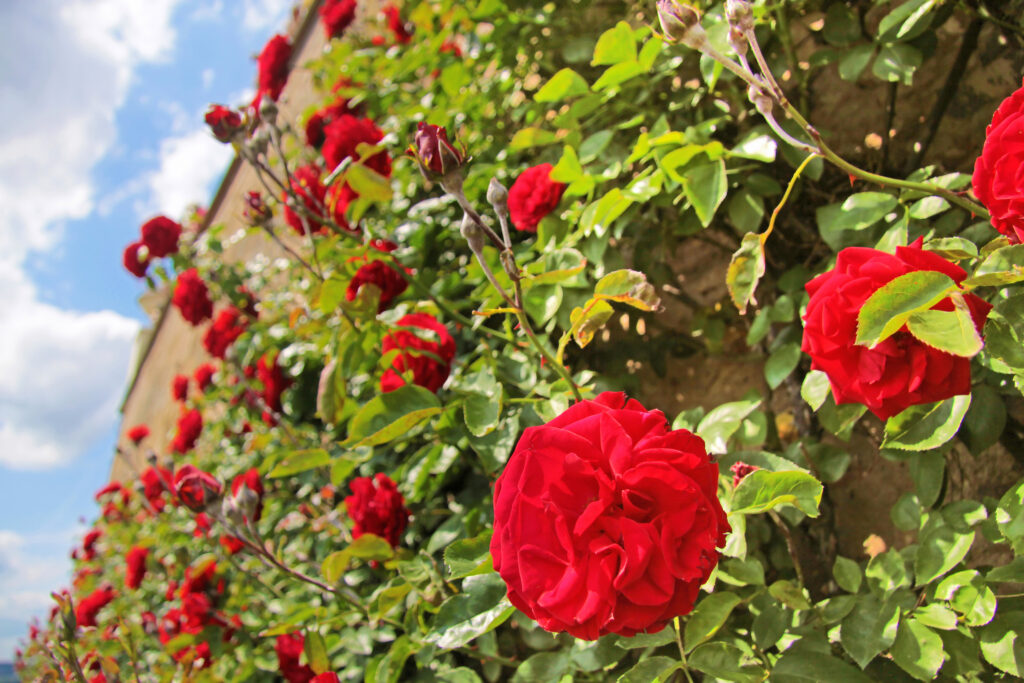
Most climbing roses bloom on wood produced the previous season, so winter protection is essential for maximum performance in all but the most protected sites. Winterizing climbing roses is best done by laying the canes down, staking them to the ground, and covering them with 4 to 6 inches of soil just before the ground freezes. Cover the soil mound with 6 to 12 inches of mulch after the soil freezes lightly. If the canes can’t be brought down, they can be tied together and insulated with straw. Hill up the base of the plant with soil, then pack straw around the canes and wrap the entire bundle with burlap to hold mulch in place.
When To Remove Winter Rose Protection
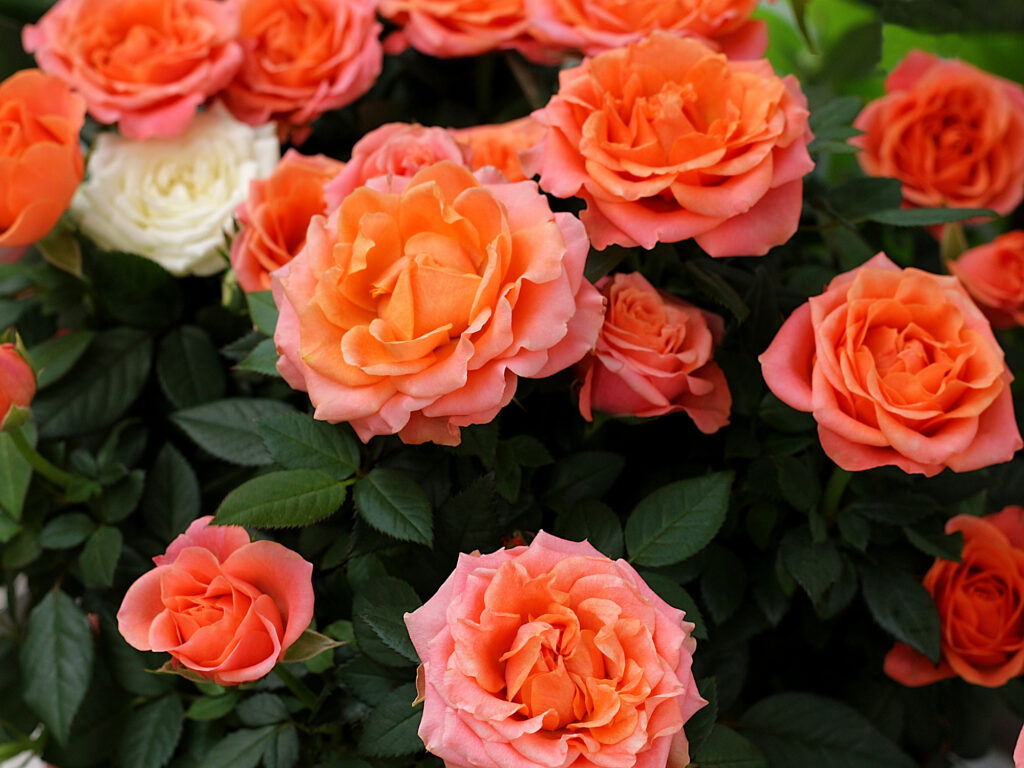
Winter protection can be gradually removed in the spring as the soil thaws and warmer temperatures return. This is generally in early to mid-April in southern Wisconsin. Most heavy annual pruning will be done at this time. In the event of unseasonably cold weather after the plants have resumed growth, provide temporary protection by covering them with a bedsheet, burlap bags, or use floating row covers. Remove any covers during the heat of the day, and replace them at sunset if light freezes are expected.

If you haven’t already started preparing, it’s best to get started soon especially in colder zones. With a little bit of extra care, your roses will make it through winter and flourish in spring.
Other Recommended Reading

- Popular Rose Types
- Guide To The Meaning Of Rose Colors
- Rose Pests – Identification & Solutions
- Choosing The Right Vine For The Right Space
- Bareroot vs Potted Plants: What Is The Difference?
At Jung Seed Co, we strive to be your go-to guide for all your gardening needs. Our YouTube channel The Garden Doctor by Dick Zondag is where he provides gardening tips for all levels of gardeners. When you need reliable gardening advice, turn to the trusted experts at Jung.
View our new catalog online or browse our website for your gardening favorites. To receive info on new products, exclusive deals, and specials, be sure to sign up for our weekly email. Join our Facebook page, to discuss all things gardening!
Original Author: Allen R. Pyle, professional horticulturist.
